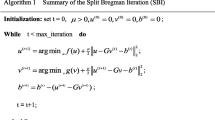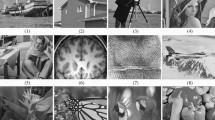Abstract
This paper develops a novel adaptive gradient-based block compressive sensing (AGbBCS_SP) methodology for noisy image compression and reconstruction. The AGbBCS_SP approach splits an image into blocks by maximizing their sparsity, and reconstructs images by solving a convex optimization problem. In block compressive sensing, the commonly used square block shapes cannot always produce the best results. The main contribution of our paper is to provide an adaptive method for block shape selection, improving noisy image reconstruction performance. The proposed algorithm can adaptively achieve better results by using the sparsity of pixels to adaptively select block shape. Experimental results with different image sets demonstrate that our AGbBCS_SP method is able to achieve better performance, in terms of peak signal to noise ratio (PSNR) and computational cost, than several classical algorithms.
















Similar content being viewed by others
References
Beck A, Teboulle M (2009) A fast iterative shrinkage-thresholding algorithm for linear inverse problems. Siam J Imaging Sci 2(1):183–202
Bi D, Xie Y, Li X, Zheng YR (2016) Efficient 2-D synthetic aperture radar image reconstruction from compressed sampling using a parallel operator splitting structure. Digit Signal Process 50:171–179
Bigot J, Boyer C, Weiss P (2016) An analysis of block sampling strategies in compressed sensing. IEEE Trans Inf Theory 62(4):2125–2139
Blumensath T, Davies ME (2009) Iterative hard thresholding for compressed sensing. Appl Comput Harmon Anal 27(3):265–274
Bo C, Wang D (2015) A registration-based tracking algorithm based on noise separation. Opt-Int J Light Electron Opt 126(24):5806–5811
Cai TT, Wang L (2011) Orthogonal matching pursuit for sparse signal recovery with noise. IEEE Trans Inf Theory 57(7):4680–4688
Chartrand R (2007) Exact reconstruction of sparse signals via nonconvex minimization. IEEE Signal Process Lett 14(10):707–710
Chen SS, Donoho DL, Saunders MA (1998) Atomic decomposition by basis pursuit. SIAM J Sci Comput 20(1):33–61
Cui H, Zhang S, Gan X, Shen M, Wang X, Tian X (2016) Information recovery via block compressed sensing in wireless sensor networks. In: 2016 IEEE international conference on communications (ICC), pp 1–6
Dai W, Milenkovic O (2009) Subspace pursuit for compressive sensing signal reconstruction. IEEE Trans Inf Theory 55(5):2230–2249
Daubechies I, DeVore R, Fornasier M, Güntürk CS (2010) Iteratively reweighted least squares minimization for sparse recovery. Commun Pur Appl Math 63(1):1–38
Davenport MA, Needell D, Wakin MB (2013) Signal space CoSaMP for sparse recovery with redundant dictionaries. IEEE Trans Inf Theory 59(10):6820–6829
Deswal S, Singhania S, Gupta S, Garg P (2016) An optimised fuzzy approach to remove mixed noise from images. International Journal of Signal Processing. Image Process Pattern Recogn 9(4):293–322
Donoho DL (1995) De-noising by soft-thresholding. IEEE Trans Inf Theory 41(3):613–627
Donoho DL (2006) Compressed sensing. IEEE Trans Inf Theory 52(4):1289–1306
Donoho DL, Elad M, Temlyakov VN (2006) Stable recovery of sparse overcomplete representations in the presence of noise. IEEE Trans Inf Theory 52(1):6–18
Eldar YC, Kuppinger P, Bölcskei H (2010) Block-sparse signals: Uncertainty relations and efficient recovery. IEEE Trans Signal Process 58(6):3042–3054
Fowler JE, Mun S, Tramel EW (2015) Multiscale block compressed sensing with smoothed projected Landweber reconstruction. In: 2011 European signal processing conference, pp 564–568
Gan L (2007) Block compressed sensing of natural images. In: 2007 15th international conference on digital signal processing. IEEE, pp 403–406
Gilbert AC, Hemenway B, Rudra A, Strauss MJ, Wootters M (2012) Recovering simple signals. In: Information Theory and Applications Workshop (ITA), pp 382–391
Huggins PS, Zucker SW (2007) Greedy basis pursuit. IEEE Trans Signal Process 55(7):3760–3772
Hurley N, Rickard S (2009) Comparing measures of sparsity. IEEE Trans Inf Theory 55(10):4723–4741
Jegou H, Douze M, Schmid C (2008) Hamming embedding and weak geometric consistency for large scale image search. Computer Vision–ECCV 2008, pp 304–317
Li S, Da Xu L, Wang X (2013) Compressed sensing signal and data acquisition in wireless sensor networks and internet of things. IEEE Trans Ind Inf 9(4):2177–2186
Li F, Lu H, Wang D, Wu Y, Zhang K (2016) Dual group structured tracking. IEEE Trans Circ Syst Video Technol 26(9):1697–1708
Liu H, Wang W (2015) Block compressed sensing reconstruction with adaptive-thresholding projected landweber for aerial imagery. J Appl Remote Sens 9(1):095,037–095,037
Lu W, Vaswani N (2010) Modified basis pursuit denoising (modified-BPDN) for noisy compressive sensing with partially known support. In: 2010 IEEE international conference on acoustics speech and signal processing (ICASSP), pp 3926–3929
Lu H, Li Y, Mu S, Wang D, Kim H, Serikawa S (2017) Motor anomaly detection for unmanned aerial vehicles using reinforcement learning. IEEE Internet of Things Journal
Lu H, Li B, Zhu J, Li Y, Li Y, Xu X, He L, Li X, Li J, Serikawa S (2017) Wound intensity correction and segmentation with convolutional neural networks. Concurr Comput: Pract Exper 29(6):e3927
Lu H, Li Y, Chen M, Kim H, Serikawa S (2018) Brain intelligence: go beyond artificial intelligence. Mob Netw Appl 23(2):368–375
Lu H, Li Y, Uemura T, Kim H, Serikawa S (2018) Low illumination underwater light field images reconstruction using deep convolutional neural networks. Future Generation Computer Systems
Melli SA, Wahid KA, Babyn P, Montgomery J, Snead E, El-Gayed A, Pettitt M, Wolkowski B, Wesolowski M (2016) A compressed sensing based reconstruction algorithm for synchrotron source propagation-based x-ray phase contrast computed tomography. Nuclear Instrum Methods Phys Res Sect A: Accelerators, Spectrometers, Detectors Assoc Equip 806:307–317
Mun S, Fowler JE (2009) Block compressed sensing of images using directional transforms. In: 2009 16th IEEE international conference on image processing (ICIP). IEEE, pp 3021–3024
Mun S, Fowler JE (2012) DPCM for quantized block-based compressed sensing of images. In: 2012 Proceedings of the 20th European signal processing conference (EUSIPCO). IEEE, pp 1424–1428
Needell D, Tropp JA (2009) cosaMP: Iterative signal recovery from incomplete and inaccurate samples. Appl Comput Harmon Anal 26(3):301–321
Needell D, Vershynin R (2009) Uniform uncertainty principle and signal recovery via regularized orthogonal matching pursuit. Found Comput Math 9(3):317–334
Osher S, Mao Y, Dong B, Yin W (2011) Fast linearized Bregman iteration for compressive sensing and sparse denoising. arXiv:1104.0262
Parikh N, Ream JM, Zhang HC, Block KT, Chandarana H, Rosenkrantz AB (2016) Performance of simultaneous high temporal resolution quantitative perfusion imaging of bladder tumors and conventional multi-phase urography using a novel free-breathing continuously acquired radial compressed-sensing mri sequence. Magn Reson Imaging 34(5):694–698
Qaisar S, Bilal RM, Iqbal W, Naureen M, Lee S (2013) Compressive sensing: from theory to applications, a survey. J Commun Netw 15(5):443–456
Qin Z, Liu Y, Gao Y, Elkashlan M, Nallanathan A (2017) Wireless powered cognitive radio networks with compressive sensing and matrix completion. IEEE Trans Commun 65(4):1464–1476
Ren X, Qiao L (2016) A novel strategy for inverse synthetic aperture radar imaging based on improved compressive sensing. IEEJ Trans Electr Electron Eng 11(2):140–145
Safavi SH, Torkamani-Azar F (2016) Sparsity-aware adaptive block-based compressive sensing. IET Signal Process 11(1):36–42
Serikawa S, Lu H (2014) Underwater image dehazing using joint trilateral filter. Comput Electr Eng 40(1):41–50
Tropp JA, Gilbert AC (2007) Signal recovery from random measurements via orthogonal matching pursuit. IEEE Trans Inf Theory 53(12):4655–4666
Ulyanov D, Vedaldi A, Lempitsky V (2018) Deep image prior. In: IEEE conference on computer vision and pattern recognition, pp 9446–9454
Unde AS, Deepthi P (2017) Block compressive sensing: Individual and joint reconstruction of correlated images. J Vis Commun Image Represent 44:187–197
Wang J, Kwon S, Li P, Shim B (2016) Recovery of sparse signals via generalized orthogonal matching pursuit: a new analysis. IEEE Trans Signal Process 64(4):1076–1089
Xu J, Qiao Y, Fu Z (2016) Adaptive perceptual block compressive sensing for image compression. IEICE Trans Inf Syst 99(6):1702–1706
You H, Zhu J (2015) Image reconstruction based on block-based compressive sensing. In: Proceedings of the 38th Australasian Computer Science Conference (ACSC 2015), vol 27, pp 30
Zhang Z, Jung TP, Makeig S, Rao BD (2013) Compressed sensing for energy-efficient wireless telemonitoring of noninvasive fetal ECG via block sparse Bayesian learning. IEEE Trans Biomed Eng 60(2):300–309
Zhao H, Wang Y, Qiao Z, Fu B (2014) Solder joint imagery compressing and recovery based on compressive sensing. Soldering Surf Mount Technol 26(3):129–138
Zhao H, Zhao H, Chen J, Chen J, Xu S, Xu S, Wang Y, Wang Y, Qiao Z, Qiao Z (2016) Compressive sensing for noisy solder joint imagery based on convex optimization. Soldering Surf Mount Technol 28(2):114–122
Zhao C, Ma S, Zhang J, Xiong R, Gao W (2017) Video compressive sensing reconstruction via reweighted residual sparsity. IEEE Trans Circ Syst Video Technol 27(6):1182–1195
Zhao W, Lu H, Wang D (2018) Multisensor image fusion and enhancement in spectral total variation domain. IEEE Trans Multimed 20(4):866–879
Zhao H, Rosin PL, Lai YK, Zheng J, Wang Y (2020) Adaptive block compressive sensing for noisy images. In: Cognitive internet of things: frameworks, tools and applications. ISAIR 2018. Studies in computational intelligence, vol 810, Springer, Cham, pp 389–399
Acknowledgments
This work was supported by National Natural Science Foundation of China (61503128), Science and Technology Plan Project of Hunan Province (2016TP1020), Scientific Research Fund of Hunan Provincial Education Department (16C0226,17C0223,18A333), Hengyang guided science and technology projects and Application-oriented Special Disciplines (Hengkefa [2018]60-31), Double First-Class University Project of Hunan Province (Xiangjiaotong [2018]469), Hunan Province Special Funds of Central Government for Guiding Local Science and Technology Development (2018CT5001) and Subject Group Construction Project of Hengyang Normal University (18XKQ02). We would like to thank NVIDIA for the GPU donation.
Author information
Authors and Affiliations
Corresponding author
Additional information
Publisher’s note
Springer Nature remains neutral with regard to jurisdictional claims in published maps and institutional affiliations.
Rights and permissions
About this article
Cite this article
Zhao, HH., Rosin, P.L., Lai, YK. et al. Adaptive gradient-based block compressive sensing with sparsity for noisy images. Multimed Tools Appl 79, 14825–14847 (2020). https://doi.org/10.1007/s11042-019-7647-8
Received:
Revised:
Accepted:
Published:
Issue Date:
DOI: https://doi.org/10.1007/s11042-019-7647-8




